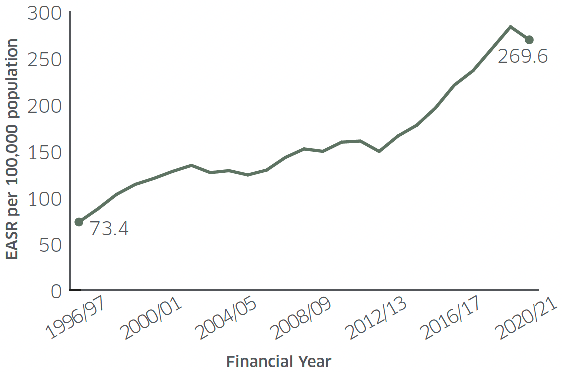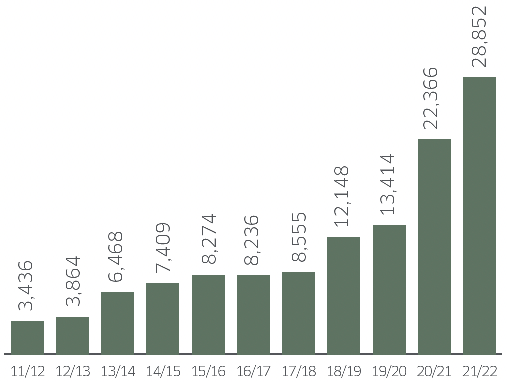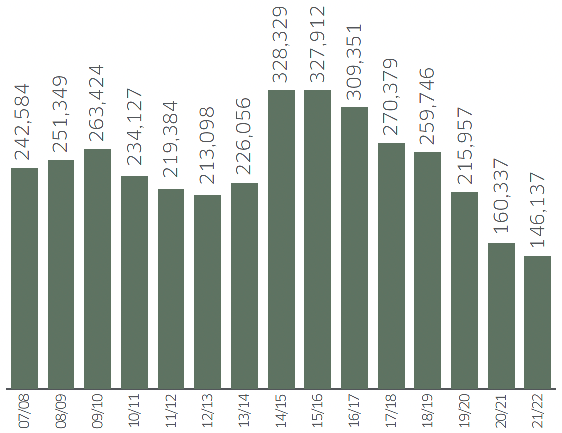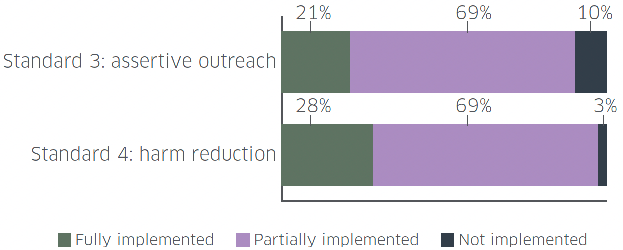National Mission on Drugs: annual report 2021 to 2022
Sets out the progress made between January 2021 and 31 March 2022 by national government, local government and third sector partners towards reducing drug deaths and improving the lives of those impacted by drugs in Scotland.
4. Outcome 2: Risk is reduced for people who take harmful drugs
4.1 Overview
People are entitled to support that reduces the harms associated with drug use regardless of where they are on their recovery journey. This includes promoting safer drug consumption practices, preventing overdoses and reducing risks when they do occur by addressing the harms caused by injecting drug use. This aligns with Standard 3 of the Medication Assisted Treatment (MAT) standards: 'All people at high risk of drug-related harm are proactively identified and offered support to commence or continue MAT.' and Standard 4: 'All people are offered evidence-based harm reduction at the point of MAT delivery.'
4.2 Progress in 2021-22
4.2.1 National Naloxone Programme
Naloxone is an opiate agonist treatment which can be administered to reverse the effects of opiate overdose.
Scotland's National Naloxone Programme, which was launched in 2010, aims to prevent fatal opioid overdoses. The programme was significantly stepped up in 2020 and 2021 leading to a doubling in the number of kits supplied. Take-home naloxone kits are issued to people at risk of opioid overdose, their friends and family and service workers in order to help prevent overdose deaths.
A range of key partners contributed to significantly increase the distribution and availability of naloxone including the DDTF. Including; equipping emergency workers with naloxone, increasing peer to peer distribution of the medicine and Scottish Families Affected by Alcohol and Drugs (SFAD) click and collect service.
In 2021, the Scottish Government in partnership with Scottish Drugs Forum (SDF) launched 'How to save a life' a high profile, mass media campaign. SDF shaped the campaign and delivered it across Scotland, with Government funding exceeding £850,000. The official campaign ran for 8 weeks from 30 August 2021 to 24 October 2021. A booster campaign followed, from 13 December 2021 to 13 January 2022.
The campaign consisted of television, radio, billboard, bus and train advertising as well as online messaging to promote intervention when someone experiences a drug overdose. The public have been encouraged to learn how to recognise an overdose and intervene to save lives. The campaign also encourages the public to order the freely available medication.
A dedicated website supported the campaign, Stop the Deaths, where people can learn more about recognising overdose; what to do in the event of an overdose; access further online information on naloxone and order a naloxone kit.
Two academic studies were funded through the DDTF research fund to evaluate the naloxone campaign.
An academic study of the impact of the Naloxone Peer Training and Supply Programme (NPTSP) at the individual and community level found that implementation of the programme was associated with an increased supply of naloxone compared to health boards where the programme was not implemented.[15]
An evaluation of the Police Scotland Naloxone pilot[16] found that by the end of the pilot, 808 officers had been trained in the use of naloxone, representing 87% of the workforce in the pilot areas; uptake of naloxone packs by police officers at the end of training sessions was 81% (656 packs) and between March and October 2021 there were 51 naloxone administration incidents where a suspected opioid overdose was treated. The evaluation found that the supply of naloxone and training in its use was both feasible for and acceptable to police officers.
Following the pilot, the Chief Constable has since approved the Scotland-wide roll out and the intention is to issue naloxone to all operational officers up to the rank of Inspector (approximately 12,000 individuals).
The funding for the Naloxone kits has been allocated via Health Boards to Police Scotland and each police division will work closely with relevant Health Board and local Naloxone lead to ensure the kits can be distributed accordingly as per demand and any wastage in minimised. Police Scotland's Drugs Strategy Board will retain oversight of the delivery of the programme and will report on progress via the Chief Constable to the SPA.
4.2.2 WAND
The WAND initiative by NHS Greater Glasgow and Clyde aims to provide a multi-agency harm reduction response to the four main harms associated with drug injecting including HIV, injecting complications, drug deaths and overdose.
The four interventions are:
Wound Care
Assessment of Injecting Risk
Naloxone
Dry Blood Spot Testing
The initiative became operational on 1st September 2020 and continues to run. There were a total 831 individuals who accessed the initiative between 1st September 2020 to 31st August 2021 (around 40% returning within the time period to repeat). This generated 1,208 full WANDs, equating to nearly 5,000 harm reduction interventions.
4.2.3 Safer Drug Consumption Facilities
Safer consumption facilities are designed to reduce harms and prevent drug overdoses. Safer consumption facilities are an evidenced based[17] intervention to reduce harms and prevent drug overdoses by providing safer, supervised places for people to use their drugs. While currently prohibited under the UK misuse of drugs act we worked with partners to examine how a safer drug consumption facility could operate within the existing legal framework and continue to progress this work.
A service specification has been developed and the details shared with Crown Office (COPFS), following detailed partnership working between the Scottish Government, Glasgow Health and Social Care Partnership, Police Scotland and the COPFS. The specification, which seeks to meet the parameters set out in the Lord Advocate's statement on 3 November, will now be considered by COPFS. If appropriate, it will then be referred to the Lord Advocate for consideration of any related statement of prosecution policy.
4.2.4 Heroin Assisted Treatment
Heroin Assisted Treatment is an Enhanced Drug Treatment Service (EDTS) which involves the provision of a heroin substitute to people with longstanding problem substance use under supervised conditions and has been shown to reduce the use of street drugs and increase the likelihood of individuals remaining in treatment.
The first EDTS service in Scotland opened in Glasgow in November 2019 which is the subject of a large scale evaluation supported by the Scottish Government Chief Scientist Office (CSO) and Glasgow Caledonian University. The findings, due to be published in late 2022, will help shape the future of the Glasgow service and create blueprint for similar facilities in Scotland.
We are committed to supporting further HAT services across the country and continue to work with local areas to explore this.
4.2.5 Benzodiazepines
Given that there is no equivalent of OST or MAT for those people who are impacted by other substances such as benzos, the Scottish Government has endorsed harm reduction and treatment guidance published by the Drug Deaths Taskforce. The guidance aims to assist treatment services in how they should engage with people around benzo use in a way which covers them by the Medication Assisted Treatment standards.
We have worked closely with Public Health Scotland to mainstream the use of this guidance across local services and in primary care in particular through an expert group of practitioners and including the voice of lived and living experience. This group has also considered what guidance and assurance is further required for prescribers who may wish to consider prescribing benzodiazepines where appropriate to protect people from illicit street benzos.
4.2.6 Digital Lifelines
Digital Lifelines Scotland seeks to increase digital inclusion and design new digital solutions with and for people with multiple and complex needs, at increased risk of drug-related harm. Up to £2.75 million of investment was announced in February 2021, of which £0.5 million was committed from Drug Deaths Taskforce funds.
The funding was used to supply and distribute smart phones and other appropriate devices, providing data and to build the skills and confidence of people using services, and those who support them.
The programme is led by Digital Health and Care at the Scottish Government with Drugs Research Network Scotland (DRNS), the Scottish Council for Voluntary Organisations (SCVO), Turning Point Scotland (TPS), Connecting Scotland and the Digital Health and Care Innovation Centre (DHI).
An approach informed by the Scottish Approach to Service Design, is used to ensure that the needs of the affected people are fully considered before co-designing appropriate solutions.
Led by SCVO an 'Early Adopter' digital inclusion grant programme for 9 organisations has been delivered. Part of discovery, this reflected on what is currently working and influences the wider programme.
4.3 Measuring Progress
This section presents some of the statistics and potential indicators for Outcome 2 (risk is reduced for people who take harmful drugs). It summarises what the available data and evidence tells us about progress in the reporting period.
4.3.1 Measuring progress: Drug-related hospital stays
Statistics on hospital stays in relation to a drug use diagnosis provide an insight into the harms associated with drug use across Scotland.[f],[18] There were 14,310 drug-related hospital stays in 2020/21. The drug-related stay rate has increased steadily over the time series, increasing more than threefold from 87 to 284 stays per 100,000 population between 1997/98 and 2019/20, before decreasing to 270 stays per 100,000 in 2020/21 (Figure 5). The highest stay rates are consistently associated with opioids.

Source: Public Health Scotland, Drug-related hospital statistics Scotland 2020/21, 2021 (National Statistics). EASR is European Age Standardised Rate, uses European Standard Population 2013 and National Records of Scotland 2020 mid-year population estimates.
Trends in drug-related patient rates provide clear evidence of an aging patient profile and the highest patient rates are among people aged 35-44 years. Male and female patient rates have both followed similar trends, each increasing more than threefold over the time series, and both decreasing in 2020/21. The drug-related stay rate for under 25 year olds has gradually increased since 2012/13.
Patients in the most deprived areas have consistently been most likely to experience a drug-related hospital stay in Scotland – each year across the time series approximately half of patients with a drug-related general acute/psychiatric were living in the 20% most deprived areas in Scotland.
4.3.2 Measuring progress: Naloxone distribution
Scotland's National Naloxone Programme (NNP) aims to prevent fatal opioid overdoses by increasing the distribution and availability of naloxone, a medicine that can temporarily reverse the effects of an opioid overdose. Following suitable training, 'take-home' naloxone (THN) kits are issued to people at risk of opioid overdose, their friends and family and service workers.
The number of THN kits issued each year has increased over the time series[19] (Figure 6). Large percentage increases in THN supply were observed in recent years. A total of 28,852 THN kits were supplied in financial year 2021/22 across all services and settings, the highest annual total since the beginning of the Programme. At the end of 2021/22, a total of 123,022 THN kits had been supplied in Scotland over the course of the NNP.

Source: Public Health Scotland, National naloxone programme Scotland – Quarterly monitoring bulletin January to March (Q4) 2021/22, 2022 (Management Information)
At the end of 2021/22 Quarter 4, the 'reach' of the NNP[g] was estimated to be 64.7%, an increase of 1.3 percentage points compared to 2021/22 Quarter 3 (63.4%).
28,852 THN kits issued in Scotland in 2021/22, a 29% increase on 2020/21 (22,366) and the highest annual total since the beginning of the NNP.
9,221 THN kits supplied between October and December 2021, the largest number of kits supplied in a single calendar quarter.
64.7% Percentage of people at risk of an opioid overdose who have been supplied with THN (as at end 2021/22).
4.3.3 Measuring progress: Injecting equipment provision
The provision of injecting equipment is effective in reducing injecting risk behaviours in people who inject drugs. This intervention helps prevent the transmission of blood borne viruses such as hepatitis C and HIV among people who inject drugs.
Injecting behaviour
There has been a general downward trend in people reporting current injecting.[20] In 2020/21, the percentage of people assessed for specialist drug treatment who reported that they were currently injecting drugs was 9%, a substantial decrease from 28% in 2006/07.[h] The sharing of needles/syringes was reported by 4% of people in 2020/21; this percentage decreased from 11% in 2006/07 to 6% in 2011/12 and has remained fairly stable since. However, there has been a marked increase in reported injecting of cocaine over time. This carries additional risks and has been linked to an outbreak of HIV among people who inject drugs in the NHS Greater Glasgow & Clyde area.[21]
Injecting equipment outlets
The number of outlets reporting injecting equipment provision has ranged between 281 and 330 outlets each year since 2011/12.[22] In 2021/22, the number of outlets reporting injecting equipment provision was 321, the second highest number recorded since data collection began in 2007/08, and a 3% decrease compared to 2020/21 (330).
321 Number of injecting equipment provision outlets in Scotland, 2021/22
146,137 Number of attendances reported by injecting equipment provision outlets in Scotland, 2021/22
Injecting equipment provision attendances
There has been a steady decrease in attendances at injecting equipment provision outlets over recent years (Figure 7) – there were 146,137 attendances in 2021/22, the lowest number of attendances ever reported and 9% fewer than in 2020/21 (160,337). Possible explanations include changes in drug use patterns or changes in the use of alternatives to injecting, changes in practise for recording attendances, changes in the accessibility and acceptability of injecting equipment provision services from people who could benefit from them, and the impact of restrictions related to COVID-19.

Source: Public Health Scotland, Injecting equipment provision in Scotland - 2021 to 2022 - Injecting equipment provision in Scotland
4.3.4 Measuring progress: Implementation of MAT standards 3 & 4
In June 2022, Public Health Scotland published a benchmarking report on the progress that alcohol and drug partnerships (ADPs) in Scotland are making to meet the MAT standards.[23] The report details the status of the implementation of the new treatment standards as at April 2022, and highlights some of the changes being made to introduce these new standards across Scotland.
MAT Standard 3 is focussed on assertive outreach and anticipatory care. Overall, this standard is partially implemented across Scotland. Of 29 ADP areas assessed, the standard was fully implemented in 6 ADP areas (21%), partially implemented in 20 ADP areas (69%) and not implemented in 3 ADP areas (10%).
MAT Standard 4 focusses on harm reduction. Overall, this standard was partially implemented. Of 29 ADP areas assessed, the standard is fully implemented in 8 ADP areas (28%), partially implemented in 20 ADP areas (69%) and not implemented in 1 ADP areas (3%).

Source: Public Health Scotland, National benchmarking report on implementation of the Medication Assisted Treatment (MAT) standards 2021-22, 2022 (Experimental Statistics)
Contact
There is a problem
Thanks for your feedback